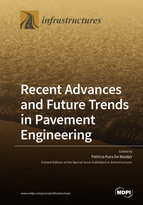Recent Advances and Future Trends in Pavement Engineering
A special issue of Infrastructures (ISSN 2412-3811).
Deadline for manuscript submissions: closed (30 November 2019) | Viewed by 79337
Special Issue Editor
Interests: fiber Bragg grating (FBG) sensor monitoring systems; concrete technology; asphalt and bitumen; recycling of industrial wastes and byproducts
Special Issues, Collections and Topics in MDPI journals
Special Issue Information
Dear Colleagues,
Pavement engineering uses engineering techniques to design and maintain flexible (asphalt) and rigid (concrete) pavements. Pavement design has gradually evolved within the last century. Prior to the early 1920s, for example, the thickness of pavement was based purely on experience, in the late 1990s, it was already based on application of various developed methods for determining the required thickness of the pavement. The acquired real information regarding traffic and climate in pavement design was possible due to move from empirical methods to mechanistic empirical methods in pavement design, where sound principles were used, for example, to predict stress and strain. Nowadays, a certain difference in quality between designed and constructed pavements is still observed. Therefore, current pavement design, construction and maintenance requirements must be improved. This refers to: 1) real-time data collection (not prediction) from the current traffic intensity and loading, pavement behavior (stress and strain), pavement temperature at different layers, etc.; 2) effective pavement structural design; 3) pavement mix design; 4) pavement bituminous and alternative materials; and 5) application of innovative technologies for the pavement construction, compaction, monitoring and maintenance. Prof. André A.A. Molenaar mentioned during ISAP2018 that “in reality strain signals are completely different from what we use in our tests” but we can verify predicted stress and strain values with real-time values by the monitoring of pavements, for example, by means of installation of fiber Bragg grating sensors in pavement. In the era for industrial technology, asphalt and concrete materials can be integrated into the category of smart materials. Therefore, in a few years, asphalt and concrete industries will need to accommodate more to the innovative solutions for the construction and maintenance of pavements.
This Special Issue, “Recent Advance and Future Trends in Pavement Engineering”, aims to provide an overview of current innovative pavement engineering ideas, which have the potential to be implemented in industry in the future, covering all recent developments in pavement design, its construction and monitoring.
Ms. Patricia Kara De MaeijerGuest Editor
Manuscript Submission Information
Manuscripts should be submitted online at www.mdpi.com by registering and logging in to this website. Once you are registered, click here to go to the submission form. Manuscripts can be submitted until the deadline. All submissions that pass pre-check are peer-reviewed. Accepted papers will be published continuously in the journal (as soon as accepted) and will be listed together on the special issue website. Research articles, review articles as well as short communications are invited. For planned papers, a title and short abstract (about 100 words) can be sent to the Editorial Office for announcement on this website.
Submitted manuscripts should not have been published previously, nor be under consideration for publication elsewhere (except conference proceedings papers). All manuscripts are thoroughly refereed through a single-blind peer-review process. A guide for authors and other relevant information for submission of manuscripts is available on the Instructions for Authors page. Infrastructures is an international peer-reviewed open access monthly journal published by MDPI.
Please visit the Instructions for Authors page before submitting a manuscript. The Article Processing Charge (APC) for publication in this open access journal is 1800 CHF (Swiss Francs). Submitted papers should be well formatted and use good English. Authors may use MDPI's English editing service prior to publication or during author revisions.
Keywords
- effective pavement structural design
- modelling
- flexible and rigid pavements
- mix design
- bituminous and alternative materials
- recycled asphalt materials
- compaction
- real-time monitoring
- maintenance
- specifications






